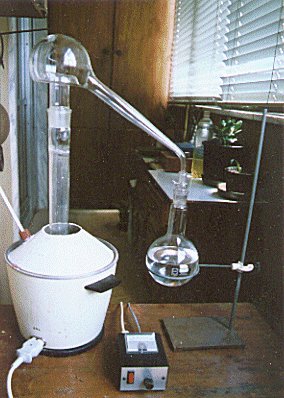Spirit of Wine II
To distil the spirit of wine you will need an alembic of good 6 litre
Pyrex glass cucurbit of plane bottom with a short neck polish female IN70 mm, and a 2
litre helm whit a short neck polish male IN70 and throat and a beak of IN19 mm.
The recipient will be a 2 litre spherical matrass with a long neck
polish female IN29 mm. Between the helm's tubular beak and the recipient will be
placed a IN19/29 mm adapter with an air hole. Also you will need a gas or electric oven
with a temperature control for sand bathing.
To begin and "to exercise the hand", acquire, at least, 50
litre of good red wine at 11 or 12%.
Pour 5 litre of wine in the cucurbit and place the helm and the
recipient with the adapter and apply silicon in all joints. Leave it for some time to
digest, in gentle fire, with a temperature of 40°C, and then distil at 80°C maximum.
When you have distilled 1 litre in the recipient, cease the
distillation and reject the phlegm that remains in the cucurbit. Of the faeces of this
phlegm you can then, extract its salts, as we will explain later on, when we speak of the
extraction of the spirit of vinegar.
Your distilled spirit will have approximately 45%. Pour it in a large
glass bottle and close it well.
In the same way, distil the remaining 45 litre of wine and join all the
distilled spirits together.
When all of the wine has been distilled, you will have 10 litre of
spirit at 45% measured on the alcoholmeter.

Wash the cucurbit and pour into it 5 litre of spirit at 45%. Place the
helm and the recipient as before and distil again, at a temperature of 80°C. When you
have distilled 2 litre of spirit, cease the distillation. The spirit will have, at least,
90%. Distil the remaining 5 litres as previously. Join this distilled spirit to the other
of the same graduation.
Now, apply an extension of 40 cm of length to the neck of your alembic
and adapt the helm to it. This increase in length of the neck is destined to hinder the
access of the water to the helm and to allow, like this, a stronger distillation.
Pour the distilled 4 litre of spirit at 90% in the cucurbit and join
to it 10% of its volume (40g) of recent quick lime. Place the helm and the recipient to
the apparel and distil at a temperature of 78°C, until just 2 litre of spirit passes in
to the recipient. Pour this spirit in a large glass bottle, close, and continue the
distillation to the recipient until 1,8 litre or less has passed.
Cease the distillation. If you proceeded step by step like we told you,
you would have distilled a spirit of wine of a great graduation near the 100% mark,
measured on the alcoholmeter at a temperature of 15°C.
If you don't get it the first time, repeat the last phase and distil a
little less of the spirit.
Keep it in a glass bottle, well closed, to avoid that the humidity of
the air alters it.
This canonical spirit of wine will be very useful in all the spagyrical
operations, mainly, in the preparation of the sweetened spirit of salt as Basil Valentine
refers to in The Last Will and Testament and in the preparation of the
vegetable and metallic tinctures.
Rubellus Petrinus